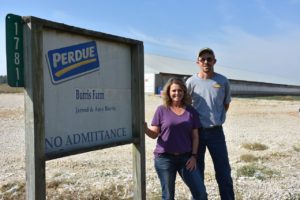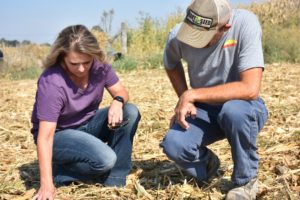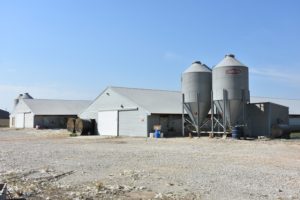
Jarrod and Amy Burris raise about 125,000 tom turkeys each year.
By Kris Vance, USDA
Jarrod and Amy Burris of Loogootee, Indiana. The core of their diversified farming operation is raising the star of most Thanksgiving dinners – turkeys.
Managing Together
Jarrod and Amy are contract turkey producers who raise about 125,000 tom turkeys per year. The turkeys are housed in one of five barns on the property and while the number of birds is substantial the Burris’ have a strong commitment to each of their birds.
For poultry raised indoors, they use temperature-controlled housing with fresh-air ventilation and a cooling system during hot summer months. The houses protect the turkeys from disease, predators, and the elements, and they are given constant access to fresh food and water, enough room to move around, and periods of light and darkness.
A fourth-generation farmer, Jarrod has been farming with his father his whole life. It wasn’t until he built his first turkey barn that Jarrod quit his job as a certified welder to become a full-time farmer. Jarrod started with three barns to house turkeys. That operation soon doubled as he added two larger barns. Jarrod knew he couldn’t continue to manage the business alone, so Amy joined him full-time in 2016.
“We had talked about me coming back to the farm full-time for quite a while,” Amy said. “I knew that I wanted to farm with him. I can’t imagine doing anything else.”

Cover crops help the soil retain moisture on their reclaimed ground.
Healthy Land
Jarrod and Amy aren’t only conscientious about how they raise their flock – they are also concerned about the welfare and health of their farm land. In addition to turkeys, the Burris family has a diverse operation that includes hogs, cattle, and 1,250 acres of row crops.
“We farm a lot of reclaimed coal mine ground and it’s hard to keep erosion under control,” said Jarrod.
To address these resource concerns, they enrolled in the Environmental Quality Incentives Program through USDA’s Natural Resources Conservation Service.
Working closely with their NRCS field staff, they’ve developed and implemented a long-term conservation plan that addresses erosion concerns and builds soil health.
The turkeys play an important role in the conservation efforts on the farmland as well. Following a nutrient management plan to minimize potential for nutrient runoff, Jarrod and Amy apply all the manure produced on their farm to their fields and rely on soil tests to tell them where to focus their manure application.
Applying manure to their reclaimed land is critical in rebuilding organic matter lost during mining and acts as a valuable soil amendment, which helps hold water and nutrients.
“Our reclaimed ground needs water about every week so we try to have a heavy cover crop on it to hold in moisture during the spring,” said Jarrod. “Applying the litter on this ground is critical in helping establish cover crops to hold that moisture and improve our soil’s organic matter.”
Their crops need the nutrients found in poultry litter to thrive, so it offsets the costs of chemical fertilizers while improving soil quality.
“Farmers’ margins are pretty tight, so your inputs have to be managed. If your soil health is where it needs to be and you’re using manure and cover crops, you are minimizing your inputs,” said Amy.
A Family Business
They expanded their grain storage and built a grain leg (an elevator to lift grain into grain bins) through a Farm Storage Facility Loan, available through USDA’s Farm Service Agency. These low interest loans help producers to build and upgrade storage facilities, including drying and handling equipment, hay barns, and facilities for cold storage.

Jarrod started with three barns to house turkeys. After doubling his operation, Amy joined him on the farm full time.
The Burris’ hope to continue the tradition and hand their farm down to the next generation. Their son, currently attending college and majoring in agronomy, has expressed interest in returning to the farm.
“It is important that we leave our land better than we found it so that our kids and grandchildren have a valuable resource,” said Amy.
More Information
USDA offers a variety of risk management, disaster assistance, loan, and conservation programs to help agricultural producers in the United States weather ups and downs in the market and recover from natural disasters as well as invest in improvements to their operations. Learn about additional programs.
For more information about USDA programs and services, contact your local USDA service center.
For an interactive version of this blog, visit #FridaysOnTheFarm.





